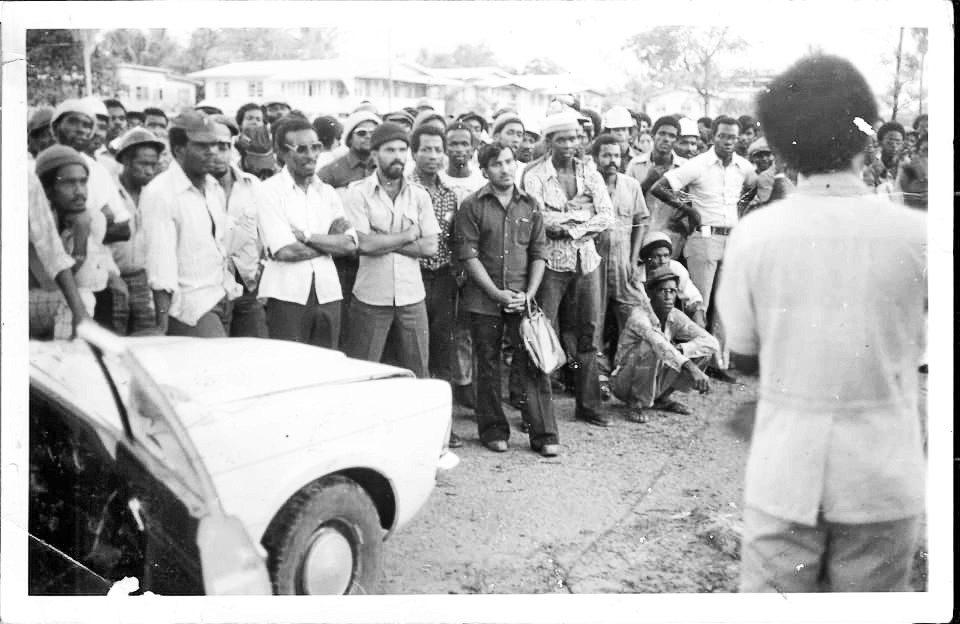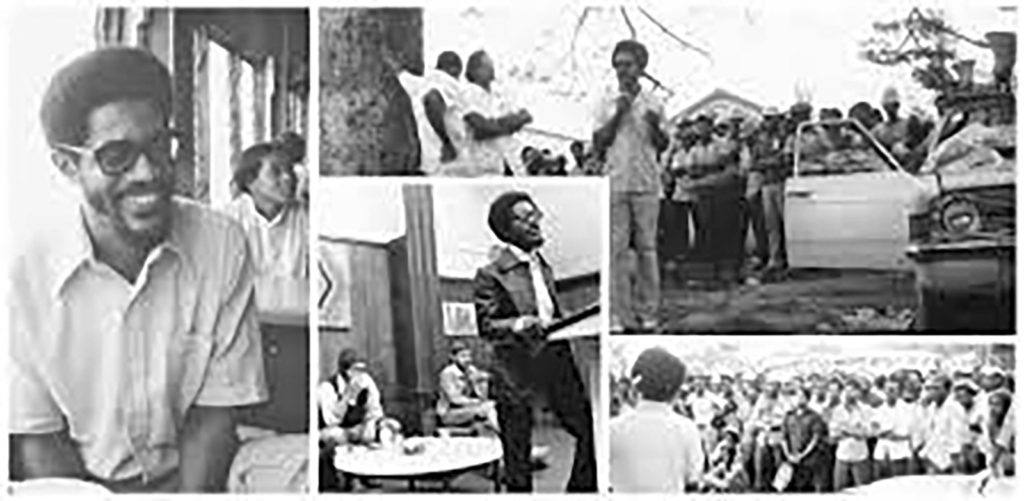Home Features Dr Walter Rodney’s take on race and class in Guyanese Politics
Below is an excerpt of a speech given by Dr Walter Rodney on race and class in Guyanese Politics
The topic has been chosen to offer me an opportunity and hopefully to offer you the opportunity also to relate to an issue of wide-ranging importance, but to do so within a very specific context, because the debate on race and class has in many instances, tended to be carried on in a very abstract and theoretical question.
Sometimes indeed, when the statement is made that race is more important than class, or vice versa it is merely a statement of ideological preference or someone’s conception of what it takes to be ideologically consistent. For the sake of illustration, some Marxists who would consider themselves orthodox they fear that to introduce the category race and to give it any valuation of importance is itself a heresy in relationship to the normal class analysis. And conversely, they are of course persons who would consider themselves as nationalists, either Black nationalists, Caribbean nationalists, African nationalists who inevitably when the category class is introduced see this, something doctrinaire, see it as a means of undermining their particular nationalist position.
It seems to me that the debate cannot really be carried on outside of a very specific historical and empirical context. Generally, to the extent that there has been an effort to locate the debate on race and class within some specific historical setting, it tends to be within the United States. It tends, therefore, to focus on the relationship between Blacks and Whites. And of course, if one went to Southern Africa and in particular to the Republic of South Africa, then the debate is also about Black and White about African and European.
In this instance, the example seems at a glance to be rather different from the standard formulation of the question of race because in Guyana, to which I will refer, the situation is one of real or imagined conflict of real and potential conflict with between two racial or ethnic groups of African and Indian ancestry. So, this is not the classical Black-White problem and it seems to me from a purely analytical viewpoint, that it is extremely useful to delve into that situation in order to see whether it allows us to have a greater grasp of the overall problem of race and class, which would normally be tackled only in relationship to Black and White.
My assessment of the situation in a broad historical framework in Guyana suggests, first of all, that racism as between Black and Brown as between African and Indian is itself derivative from the old established racism as between White and Black. That is to say that the situation in Guyana, in Trinidad, in Suriname, the situation in colonies or ex-colonies where transported peoples have been brought into conflict with each other in the new world is itself derivative from the old – the problem of racism in plantation society. That is one of my premises, I will attempt to elaborate on it as we proceed. But perhaps it will serve our purposes if from the outset, I indicated, the kinds of hypotheses and the lines of argument which I wish to follow.
The concept of Black-Brown relations having derived from the initial Black-White controversy is one of the lines of analysis. The second is that class trouble was indeed the principal motive force of Guyanese as of Caribbean history but at the same time that racism is responsible for important intraclass conflict, which is a topic that perhaps both historically and abstractly is not dealt with sufficiently. Intraclass conflicts within different classes within different strata were in fact based on real or imagined conflicts of racists. Thirdly, one of the consequences of assessing our history in Guyana is to come to the conclusion that at any given stage, the existence of racism as an aspect of consciousness, as an aspect of ideology, and the existence of racism as a facet in the structure of production relations is always guaranteed and promoted by a class outside of the working class.
That’s the genesis and the determination of racism in the society is to be located outside of the working people themselves and these are points that I will elaborate on and in the process to bring you up to date with a sort of race-class structure that has emerged in our particular part of the world.
So, to return to my first formulation, when slavery ended in the Caribbean, as many people casually really familiar with the Caribbean would know, the population was, at that time, essentially African-based, the vast majority of the population. And it was, subsequent to slavery, that a large number of other ethnic groups were introduced to fulfil the function of labour in the society.
Indian immigration was the largest single sector of immigration, but we also had immigrants from China, from the Madeira and the Azores Islands, from Europe itself too some extent, from the Caribbean islands, and so on. But the Indian immigration was the largest and the most consistent source was the subcontinent of India. Consequently, at a certain point in the late 19th century in Guyana, and indeed in Trinidad, the Indian population became first of all, a substantial minority and in the case of Guyana in the present century, they became the largest single ethnic group, and that is the basis of the so-called racial division in our society.
When African and Indian met in a Caribbean context for all practical purposes that was a first physical and or social confrontation. It was not a continuation of relations which had independently been established between Africans and Indians, and therefore it’s meant that their appreciation and evaluation of each other has to develop in situ. Whatever relations exist between Africans and Indians in the Caribbean, were developed right there in the Caribbean. They are not relations which represents a carryover from any other type of contact which Africans had with Indians. And yet, at a very early stage of the relationship between Africans and Indians in Ghana, it was acceptable that both sides were currently racial or racist barbs at each other.
Now, where the deep barbs originate? How did it develop in such a short time in the relations between Africans and Indians? In pursuing this question, it was interesting to identify the stereotype which Africans and Indians utilise with respect to each other. The stereotype of the African was brought straight from slavery.
The stereotype within our society was known as Quashie, Quashie being a gross decimation of the name Quacie. Quacie became Quashie in the creole rendition of the word and the African slave was given a series of attributes, which those who know the literature on racism would readily recognise the attributes of being lazy, of being stupid, of not at one point, although capable of carrying on the most back breaking work is still in a controversial fashion, in a contradictory fashion, regarded as lazy, regarded as given to music, given to idleness and so on and so forth. The whole package still, in one way or another, informed some of the racist literature, and the racist stereotype of the Black man. Now that was Quashie the African.
The Indians inherited that assessment, that stereotype, of Quashie. They had no notion of who Quashie was because they had not met Quashie. They had just arrived in society but they inherited lock, stock and barrel that stereotype that has derived from the plantation society.
At the same time, the modified plantation society at the post slavery era quickly built up its own stereotype of the Indian. The Indian was called Sammy. That sounds rather anglicised, but what it really referred to was the title for me Swarmy, which in effect in English version at any rate, that would be the spelling but it relates to an engine of a certain, a Hindu and a person who had religious training and a religious inclination, a pre normal. Now the word was seeking then out of the names of many Indians, like Ramsammy or Verasammy and they simply said, this is Sammy. Now Sammy was also reduced to a stereotype of a rather cunning, given to idleness also, but willing to work under certain conditions in order to advance his own aim, but not to be trusted and so on and so forth.
There is another stereotype that is built up of Sammy. And again, interestingly enough, the Africans soon acquired the stereotype of Sammy. So, the plantation society was producing its stereotypes of these two racial groups and because of its own economic as well as cultural dominance, the society imposed these stereotypes on both groups of working people, African, and Indian.
I won’t go into any further detail on that, but maybe there is a broader lesson to be drawn. In many of the studies on racism, there has arisen in the last several years, a tendency to want to try and find the roots of racism in some very distant epoch using sources like the Bible, using the very earliest contacts between Africans and Europeans, and it seems to me that one of the weaknesses of that scholarship and the methodology which it utilises is that it takes issues such as acts of individual prejudice as between Whites and Blacks, or the way that a particular Black is treated in European society, but it does not follow through to see where that prejudice is transferred from being a mere individual prejudice to being part of an institutionalised relationship.
And it is only in the plantation provide, only in the slave society of the new world that the framework was established precisely for those institutional relations. So that the racism ceased to be merely an act of personal quirk, a personal aberration and became instead a rationalisation for a whole system of production. And this is why there’s a qualitative difference between racism as understood in the new world as the developed, particularly in the 17th and 18th century and any other acts of individuals prejudice which can historically be illustrated as having occurred prior to that date.
In other words, it seems to me that even after one has illustrated that racism existed before capitalism, it still remains true that the capitalist system in a particular phase of its accumulation in which it required to subordinate non-White people in a particular way, was responsible for both aspects of modern racism, namely the involvement of race as a category in determining hope people have access to the means of production. The involvement of race in the actual production relation.
And secondly, inevitably, the dissemination of racist ideas as a necessary part of the ideological superstructure, to maintain that type of exploitation. So, it is within the Caribbean, it seems to me that one must go back, just as it is necessary, and many scholars are finding it necessary in recent times, to return to the 17th century, to return to that very decisive moment in the expansion of the European economy, when it became an international economy, to understand the genesis of capitalism on the world scale. In the same way, it seems to me that we have to look at the development of the said Caribbean society to understand the development of racism has to be.
You can listen to the full speech at https://www.youtube.com/watch?v=9szjOu-yIPs

